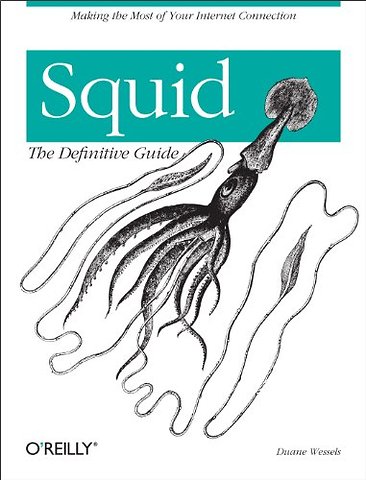Squid: The Definitive Guide
Paperback Engels 2004 1e druk 9780596001629Samenvatting
Squid is the most popular Web caching software in use today, and it works on a variety of platforms including Linux, FreeBSD, and Windows. Squid improves network performance by reducing the amount of bandwidth used when surfing the Web. It makes web pages load faster and can even reduce the load on your web server. By caching and reusing popular web content, Squid allows you to get by with smaller network connections. It also protects the host on your internal network by acting as a firewall and proxying your internal web traffic.
You can use Squid to collect statistics about the traffic on your network, prevent users from visiting inappropriate web sites at work or school, ensure that only authorized users can surf the Internet, and enhance your privacy by filtering sensitive information from web requests. Companies, schools, libraries, and organizations that use web-caching proxies can look forward to a multitude of benefits.Written by Duane Wessels, the creator of Squid, Squid: The Definitive Guide will help you configure and tune Squid for your particular situation. Newcomers to Squid will learn how to download, compile, and install code. Seasoned users of Squid will be interested in the later chapters, which tackle advanced topics such as high-performance storage options, rewriting requests, HTTP server acceleration, monitoring, debugging, and troubleshooting Squid.
Topics covered include:
- Compiling and installing Squid
- Running Squid
- Using Squid's sophisticated access controls
- Tuning disk storage for optimal performance
- Configuring your operating system for HTTP interception
- Forwarding Requests to other web caches
- Using redirectors to rewrite user requests
- Monitoring Squid with the cache manager and SNMP
Using Squid to accelerate and protect HTTP servers
- Managing bandwidth consumption with Delay Pools
Specificaties
Lezersrecensies
Inhoudsopgave
1. Introduction
Web Caching
A Brief History of Squid
Hardware and Operating System Requirements
Squid Is Open Source
Squid's Home on the Web
Getting Help
Getting Started with Squid
Exercises
2. Getting Squid
Versions and Releases
Use the Source, Luke
Precompiled Binaries
Anonymous CVS
devel.squid-cache.org
Exercises
3. Compiling and Installing
Before You Start
Unpacking the Source
Pretuning Your Kernel
The configure Script
make
make Install
Applying a Patch
Running configure Later
Exercises
4. Configuration Guide for the Eager
The squid.conf Syntax
User IDs
Port Numbers
Log File Pathnames
Access Controls
Visible Hostname
Administrative Contact Information
Next Steps
Exercises
5. Running Squid
Squid Command-Line Options
Check Your Configuration File for Errors
Initializing Cache Directories
Testing Squid in a Terminal Window
Running Squid as a Daemon Process
Boot Scripts
A chroot Environment
Stopping Squid
Reconfiguring a Running Squid Process
Rotating the Log Files
Exercises
6. All About Access Controls
Access Control Elements
Access Control Rules
Common Scenarios
Testing Access Controls
Exercises
7. Disk Cache Basics
The cache_dir Directive
Disk Space Watermarks
Object Size Limits
Allocating Objects to Cache Directories
Replacement Policies
Removing Cached Objects
refresh_pattern
Exercises
8. Advanced Disk Cache Topics
Do I Have a Disk I/O Bottleneck?
Filesystem Tuning Options
Alternative Filesystems
The aufs Storage Scheme
The diskd Storage Scheme
The coss Storage Scheme
The null Storage Scheme
Which Is Best for Me?
Exercises
9. Interception Caching
How It Works
Why (Not) Intercept?
The Network Device
Operating System Tweaks
Configure Squid
Debugging Problems
Exercises
10. Talking to Other Squids
Some Terminology
Why (Not) Use a Hierarchy?
Telling Squid About Your Neighbors
Restricting Requests to Neighbors
The Network Measurement Database
Internet Cache Protocol
Cache Digests
Hypertext Caching Protocol
Cache Array Routing Protocol
Putting It All Together
How Do I ...
Exercises
11. Redirectors
The Redirector Interface
Some Sample Redirectors
The Redirector Pool
Configuring Squid
Popular Redirectors
Exercises
12. Authentication Helpers
Configuring Squid
HTTP Basic Authentication
HTTP Digest Authentication
Microsoft NTLM Authentication
External ACLs
Exercises
13. Log Files
cache.log
access.log
store.log
referer.log
useragent.log
swap.state
Rotating the Log Files
Privacy and Security
Exercises
14. Monitoring Squid
cache.log Warnings
The Cache Manager
Using SNMP
Exercises
15. Server Accelerator Mode
Overview
Configuring Squid
Gee, That Was Confusing!
Access Controls
Content Negotiation
Gotchas
Exercises
16. Debugging and Troubleshooting
Some Common Problems
Debugging via cache.log
Core Dumps, Assertions, and Stack Traces
Replicating Problems
Reporting a Bug
Exercises
Appendix A: Config File Reference
Appendix B: The Memory Cache
Appendix C: Delay Pools
Appendix D: Filesystem Performance Benchmarks
Appendix E: Squid on Windows
Appendix F: Configuring Squid Clients
Index
Anderen die dit boek kochten, kochten ook
Rubrieken
- advisering
- algemeen management
- coaching en trainen
- communicatie en media
- economie
- financieel management
- inkoop en logistiek
- internet en social media
- it-management / ict
- juridisch
- leiderschap
- marketing
- mens en maatschappij
- non-profit
- ondernemen
- organisatiekunde
- personal finance
- personeelsmanagement
- persoonlijke effectiviteit
- projectmanagement
- psychologie
- reclame en verkoop
- strategisch management
- verandermanagement
- werk en loopbaan






